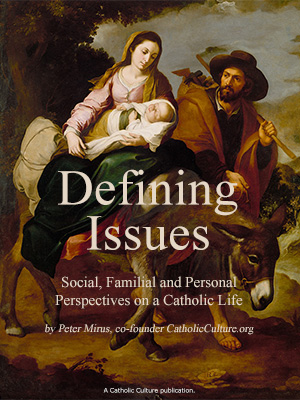Christmas Workshop
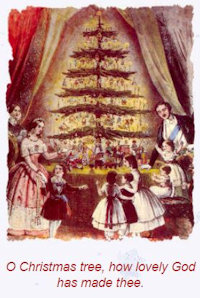 Activities & Customs
Activities & Customs
Catholic Culture invites you try out some of our suggested activities as you gather around the Christmas tree. Throughout this wonderful time there will always be much hustle and bustle, shopping and baking and gift giving. But we hope you will refer to the Catholic Culture calendar often for ideas and spiritual nuggets to increase your Christmas joy.
Let us try to celebrate Christmas with the innocence and humility of children always keeping in mind the wonderful birth of the Christ Child.
- Christ Candle
- Christmas Field Trip
- Nativity Play
- A Christmas Quiz
- Symbolic Lights and Fires of Christmas
- Posters for Advent, Christmas and Epiphany
- Christmas Ideas for Young Children
- Story of St. Wenceslaus
- New Year's Eve Activities
- New Year's Eve Party
- The Wise Men, An Epiphany Legend
- Kings' Party or Twelfth Night Party
- Twelfth Night Cake and Kings
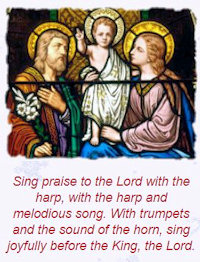 Prayers, Blessing & Hymns
Prayers, Blessing & Hymns
Blessings hold a privileged place in the Church among all other sacramentals as they lead "the faithful to praise God and prepare them for the principal effect of the sacraments." — Augustin Mayer, O.S.B. of the Congregation for Divine Worship
- Christmas Morning Prayers
- Christmas Evening Prayers
- Meal Prayers for the Christmas Season
- Dec. 24: Blessing of a Christmas Tree for the Home
- Dec. 24: Blessing of a Christmas Crib for the Home
- Dec. 28: Prayer of Parents for Their Children
- Dec. 28: Prayer to the Holy Family
- Dec. 28: Blessing of Children
- Jan. 1: Blessing for the New Year
- Jan. 8: Blessing of Epiphany Water and Chalk
- Jan. 8: Blessing of the Home on Epiphany
- Ancient Carols and Hymns
- Familiar Carols and Hymns
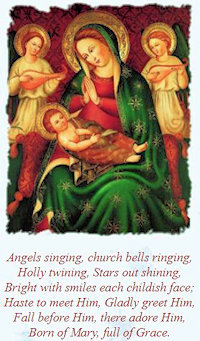 Christmas Carols
Christmas Carols
Hymns written specifically for the feast of Christmas have been around, it seems, almost as long as the feast itself. Many of these early hymns were created for and added to the Divine Office, and weren't widely known. Some of these early hymn-writers included St. Ambrose, Prudentius, and Venantius Fortunatus, Bishop of Poitiers.
Carols, which are more joyful songs associated with dance (the word “carol” comes from either the Old French term for a circle dance, carole, derived from the Latin choraula, or the Greek dance choraulein), seem to have been first introduced in the 12th century by St. Francis of Assisi, who is also credited with creating the first Nativity scene. He wanted to teach people about the birth of Jesus through music, so he added religious lyrics to well-known tunes. The concept of Christmas carols then traveled throughout Europe, including to Germany where many carols were written in the 14th century. Carols today often retain the medieval choral patterns from the tradition of these early carols. As time went on, the popularity of Christmas carols and hymns grew, and from this we have some of the most popular Christmas songs today. (Excerpted from Aquinas & More)
We offer a sampling of beautiful Christmas carols to enhance the celebration of this glorious feast.
For more carols please see The Hymns and Carols of Christmas and the Music Library.
- O Come O Come Emmanual
- Angels We Have Heard On High
- Hark! The Herald Angels Sing
- We Three Kings of Orient Are
- O Little Town of Bethlehem
- Silent Night
- Away in a Manger
- What Child Is This?
- The First Noel
- O Come, All Ye Faithful
- Joy to the World
- God Rest Ye, Merry Gentlemen
- O Christmas Tree
- Good King Wenceslas
- It Came Upon A Midnight Clear
- Lo, How A Rose E'er Blooming
O come, Thou Rod of Jesse, free
"O Come, O Come, Emmanuel" is an Advent hymn with Christian Latin tune name "Veni Emmanuel" (Come God with Us.) Its history originates in the medieval Roman Catholic Church, c.12th century. It was translated into English by John Mason Neale (1818-1866).
During the Advent season, the hymn began as a series of Antiphons. Each of the Antiphons greets the Savior with one of the various titles He is referred in the Scriptures, names such as "Emmanuel," "Lord of Might," "Key of David," and "Rod of Jesse." The text melody was originally a Plainsong or Gregorian Chant, which is the earliest form of singing in the church.
During the 19th-century there were Anglican ministers and scholars who developed a keen interest in translating into English many of the ancient Greek, Latin and German hymns, and made available the rich heritage of these Greek and Latin hymns. John Mason Neale was one of them.
Thine own from Satan's tyranny.
Shepherds, why this jubilee?
In A.D. 129, Telesphous, Bishop of Rome, ordained that, "In the Holy Night of the Nativity of our Lord and Savior, all shall solemnly sing the 'Angel's Hymn.' " With that proclaimation the 'Angels Hymn' became the first Christmas hymn of the Christian church. Its most common English version was translated in 1862 by James Chadwick, and its most memorable feature is its chorus Gloria in Excelsis Deo!, which is Latin for Glory to God in the Highest.
"This carol contains two parts that were joined together during the 19th century. The verses are part of a French carol called Les Anges dans nos Campagnes (Angels in Our Fields), and the French have sung it for centuries. Just as the shepherds in the hills around Bethlehem sang songs of praise on the first Christmas, Provencal shepherds traditionally sang in their fields on Christmas Eve, trying to recreate the wonder of another, earlier group of shepherds — shepherds who witnessed something miraculous." — The Spirit of Christmas by Virginia Reynolds
Why your joyous strains prolong?
With th' angelic hosts proclaim
The Christmas carol Hark! The Herald Angels Sing is written by Charles Wesley, the brother of John Wesley, an early leader of the Methodist church. Rich in scriptural references, the carol speaks of the mystery of the incarnation of Christ. Many scholars believe it to be one of the best songs in the English language.
"And suddenly there was with the angel a multitude of heavenly host praising God, and saying, Glory to God in the highest, and on earth peace, good will to men (Luke 2:13-14)."
The tune almost always used today was composed by Felix Mendelssohn in 1840, for his cantata Festgesang, written to commemorate Johann Gutenberg and his invention of the printing press.
"Christ is born in Bethlehem!"
O Star of wonder, star of night,
The Christmas carol We Three Kings of Orient Are was written by Reverend John Henry Hopkins, Jr. in 1857 for a Christmas pageant.
Now after Jesus was born in Bethlehem of Judea in the days of Herod the king, magi from the east arrived in Jerusalem, saying, "Where is He who has been born King of the Jews? For we saw His star in the east and have come to worship Him." Matt 2:1-2
Guided by the star, the Magi traveled to the place where Jesus, Joseph and Mary were staying. They presented their new born king with presents of gold, frankincense and myrrh. The first gift of gold identified Jesu as king, the second gift, frankincense, symbolizes his priethood, and the third gift, myrrh, prophied of his death, as myrrh was commonly used as an embalming spice in that day. The three offices of the Messiah, Prophet, Priest and King, were also represented by the gifts.
Star with royal beauty bright.
O morning stars, together, proclaim the holy birth!
As Phillips Brooks approached the village of Bethlehem on Christmas Eve, 1866, he imagined the Holy Family on their journey nearly two thousand years before, walking over the very same stones, toward the tiny town. Brooks was overcome by the beauty and peace of Bethlehem and his experience inspired him to write this song. He claimed that the Holy Land was "still singing in [his] soul" when he wrote O Little Town of Bethlehem for a children's Sunday school class two years later.
On Christmas Eve 1868, Brooks, rector of Holy Trinity Church in Philadelphia, asked the church organist to set his verses to music. The next morning, Lewis H. Redner brought the completed hymn to church, where the children's choir sang it for the first time.
And praises sing to God the King, and peace to men on earth.
Silent night, holy night,
Father Joseph Mohr was in a quandary. Christmas Eve was only hours away, but his seasonal hymn was still incomplete due to a broken organ (some say mice were the cause of the damage). Father Mohr feared that if the tune was left unfinished, Christmas 1818 would forever be remembered as Oberdorf, Germany's, "tuneless Yuletide." Happily, organist Franz Gruber rescued Mohr with a simple arrangement for voice and guitars.
When the clocks struck midnight, the just-written "Silent Night" echoed across the Bavarian village. This simple, haunting carol traveled quickly from town to town, but it took 30 years for news of its popularity to reach its amazed composers. To read the full story of "Silent Night," click here.
Son of God, love's pure light.
I love Thee, Lord Jesus, Look down from the sky,
People still call this delightful song "Luther's Cradle Hymn," and believe that Martin Luther sang his own children to sleep with it in the 15th century. None other than the song's composer, James Murray, promoted this charming fable. We really don't know who wrote the words, only that they appeared anonymously in a Lutheran publication called Little Children's Book for Schools and Family in 1885.
When the music first appeared in a children's hymnal two years later, it was entitled "Luther's Cradle Hymn." James Murray, the editor of the hymnal, wrote that the song was "composed by Martin Luther for his children, and still sung by German mothers to their little ones." Murray, who was a student of Lowell Mason (Joy to the World), then added his own initials to the end of the song, thereby ensuring over a century of confusion.
And stay by my side until morning is nigh.
Raise, raise a song on high, The virgin sings a lullaby.
What Child Is This? is a carol written by William Chatterton Dix in 1865, to the tune of Greensleeves. In the original version, each chorus offered a new text. Greensleeves is also used as the tune for The Old Year Now Away Has Fled, which is dated 1642.
"The melody Greensleeves is so old that it's impossible to date.
"There are dated references to Greensleeves as far back as 1580, and it may be that English King Henry VIII actually wrote it, but the melody probably predates his realm. We know that Good Queen Bess (Elizabeth I) danced to the melody and that Shakespeare mentions it in The Merry Wives of Windsor. It's had many different sets of lyrics, most of which weren't at all religious." — The Spirit of Christmas by Virginia Reynolds
Joy, joy for Christ is born, The Babe, the Son of Mary.
This star drew nigh to the northwest,
In the thirteenth and fourteenth centuries, Mystery Plays – dramatizations of biblical stories – were quite popular. A favorite play topic was Jesus' birth. These events were often orchestrated by singers, writers, and musicians.
Possibly of French or English origin ("Noel" is French for "Christmas"), "The First Noel" remains a descendant of these productions. Words added by William Sandys for his 1833 compendium of hymns, Christmas Carols, Ancient and Modern, mark the first time that the lyrics and music were published together.
O'er Bethlehem it took its rest.
O come, let us adore Him
John Francis Wade wrote the original manuscript. Wade, a Roman Catholic, lived in Douay, France, where he earned his living copying and teaching music. Composed between 1740 and 1744, the hymn became quite well known locally.
Adeste Fideles became popular among Roman Catholics during the latter half of the 18th century, and traveled to England by way of the Portuguese Embassy, which performed the hymn regularly at its services.
Frederick Oakeley's English translation followed almost 100 years after the original words. Also a Roman Catholic clergyman, Oakeley was a Canon of Westminster Cathedral in London. The translation probably helped the carol become popular with non-Catholic singers. The carol is commonly sung today both in English and in Latin.
O come, let us adore Him, Christ the Lord.
Joy to the world! the Saviour reigns;
The history of the popular "Joy to the World" is truly unusual. Its lyrics originated in the Old Testament as published in Isaac Watt's 1719 translation of the Psalms of David. When American composer Lowell Mason set these words to music in 1839, he added a notation alluding to George Frideric Handel as lyricist (it was common to attribute a song to Handel in those days in order to generate popularity).
Thus, for over a century, the world believed that Handel had composed the song's lyrics. Ultimately, careful sleuthing by musicologists unearthed the truth, and credit was restored to the rightful source: King David.
Let men their songs employ
Now to the Lord sing praises,
Compared to many traditional carols, "God Rest Ye, Merry Gentlemen" is a fairly recent addition to the world's library of Christmas songs.
It originally existed in the many versions sung by paid holiday street singers known as "waits." First published in 1827, it was later used by Charles Dickens in "A Christmas Carol."
The good cheer and warm wishes of this carol being sung on the street incites contempt in the crotchety, yet unconverted, Ebenezer Scrooge. This rousing Christmas favorite is lifted by the voices of friends and relatives every year.
All you within this place
O, Christmas Tree, O, Christmas Tree,
A Tannenbaum is a fir tree (die Tanne) or Christmas tree (der Weihnachtsbaum). Although most Christmas trees today are Fichten (spruce) rather than Tannen, the qualities of the evergreen have inspired musicians to write several “Tannenbaum” songs in German over the years.
The best known version was penned in 1824 by a Leipzig organist named Ernst Anschütz. The melody is an old folk tune. The first known “Tannenbaum” song lyrics date back to 1550. A similar 1615 song by Melchior Franck (1573-1639) goes: “Ach Tannebaum, ach Tannebaum, du bist ein edler Zweig! Du grünest uns den Winter, die lieben Sommerzeit.” There are at least a dozen English versions of this carol.
Folktales describing how evergreen trees came to symbolize Christmas can be found in nearly every culture. Centuries-old lore describes evergreen trees blooming in every forest on earth the night Jesus was born.
Thou hast a wondrous message.
Ye who now will bless the poor
"Good King Wenceslas is a popular Christmas carol about a king who goes out to give alms to a poor peasant on the Feast of Stephen (the second day of Christmas, December 26). During the journey, his page is about to give up the struggle against the cold weather, but is enabled to continue by the heat miraculously emanating from the king's footprints in the snow. The legend is based on the life of the historical Saint Wenceslaus I, Duke of Bohemia (907-935), known in the Czech language as Svatý Václav." —Excerpted from Wikipedia
Though history is laden with wicked royalty, this titled ruler stands tall: King Wenceslas. His kind heart was silenced by a jealous brother in 929, but, centuries later, his memory surfaced as the subject of a children's song written by John Mason Neale.
To add the perfect melody to his tribute, Neale picked an unlikely Latin tune: "Tempus adest floridum" or "Spring has unwrapped her flowers," first published in a Swedish song collection in 1582. Its application to Neale's lyrics proved to be a remarkable tribute to a beloved ruler whose kindness has never been forgotten.
Shall yourselves find blessing
O hush the noise, ye men of strife
Edmund Hamilton Sears was a Unitarian minister and graduate of Harvard's Divinity School. His original writings came to the attention of Oliver Wendell Holmes, who praised him highly. Sears, who preferred a quiet life among his New England congregation, emphasized Jesus' message of "peace on earth, good will toward men." The message of "peace" rings throughout this carol, as it rang in the hills around Bethlehem on the first Christmas. The words to It Came Upon the Midnight Clear first appeared in print in 1850 in the Christian Register.
By contrast, composer Richard S. Willis led a very public life as an editor and critic with The New York Tribune. A student of Mendelssohn and a musical journalist, Willis composed carols while acting as a vestryman at The Little Church Around the Corner in New York City. The music of the carol we sing today was actually written for another carol, While Shepherds Watched Their Flocks by Night,and was matched with Sears' words several years later.
Although Sears and Willis were from similar backgrounds, they never met.
And hear the angels sing.
She bore to us a Savior
Originally published in 1582 (or 1588) in Gebetbuchlein des Frater Conradus, this 19-stanza Catholic hymn's focus was Mary, who is compared to the mystical rose praised in the Song of Solomon 2:1: "I am a rose of Sharon, a lily of the valleys." The hymn is believed to have originated in Trier, and once source stated that on one Christmas Eve, a monk in Trier found a blooming rose while walking in the woods. He placed the rose in a vase, and placed it before the altar to the Virgin Mary. Some sources indicate the hymn might date back into the 14th Century.
"It was not printed until around 1600, though by 1609 it received a tremendous boost when it was harmonized by the famous German composer Michael Praetorius. That arrangement, which is the one most commonly used today, helped considerably in the publicizing of the carol and also led some persons to erroneously attribute the carol to Praetorius. The melody was adopted by the great German composer Johannes Brahms as the basis for an 1896 chorale prelude." – The Christmas Carol Reader (Haworth Popular Culture)
When half spent was the night
This item 12020 digitally provided courtesy of CatholicCulture.org





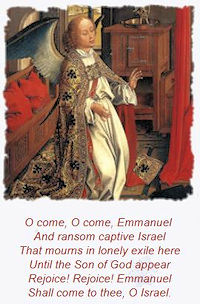 O Come, O Come, Emmanuel
O Come, O Come, Emmanuel 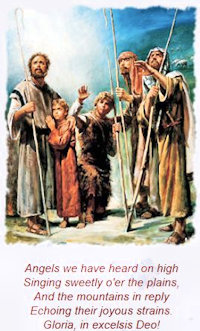
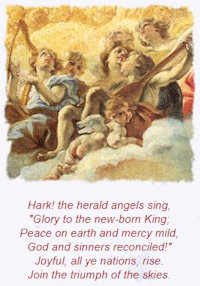 Hark! The Herald Angels Sing
Hark! The Herald Angels Sing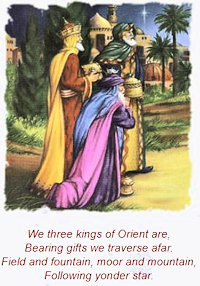 We Three Kings of Orient Are
We Three Kings of Orient Are 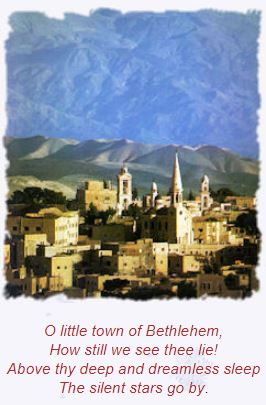 O Little Town of Bethlehem
O Little Town of Bethlehem 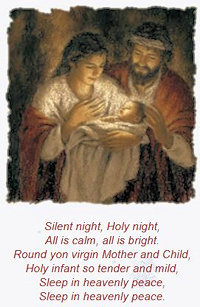 Silent Night
Silent Night 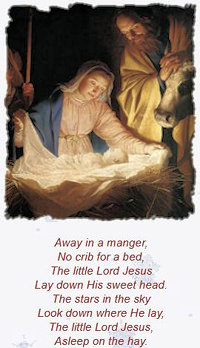 Away in a Manger
Away in a Manger 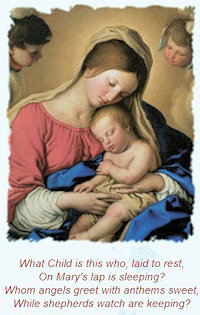
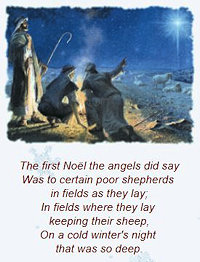 The First Noel
The First Noel 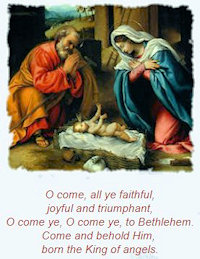
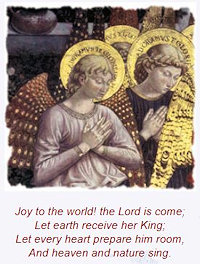 Joy to the World
Joy to the World 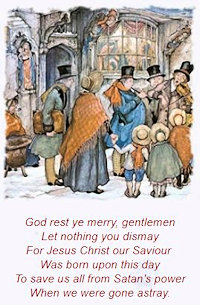
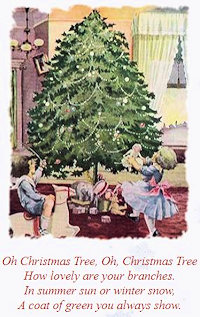
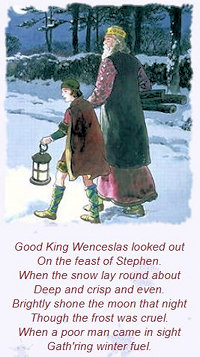
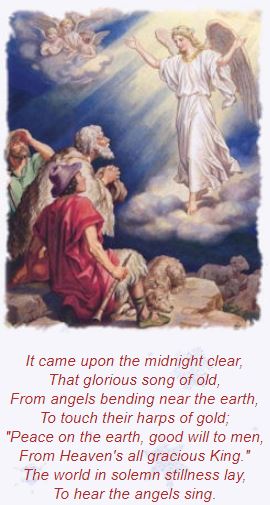
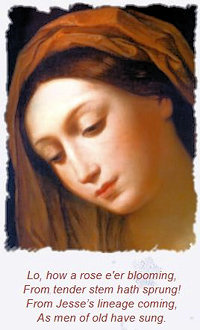 Lo How a Rose Er Blooming
Lo How a Rose Er Blooming

